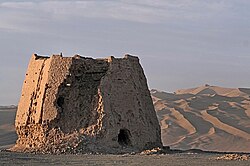Han dynasty
The Han dynasty came to power in 202 BC. They followed the laws of Confucianism and legalism. This was called 'the Han synthesis'.
The Han dynasty was considered the golden age of early China with many important events and discoveries.
History
The Han dynasty ruled China for over 400 years: from 206 B.C. to 220 A.D. Its first emperor was Liu Bang, known in Chinese as Emperor Gaozu of Han.
Emperor Gaozu maintained a legalist ideology, just like the Qin dynasty had. However, the emperor also had ideas related to Confucianism about having a centralized system showing benevolence.
After eighty years, Emperor Wu of Han launched a period of military expansion. The Han armies took control of many territories, including the extremely important Silk Road in Mongolia and Xinjiang. The Silk Road helped make the empire a political, economic, military, and cultural center, but it was very expensive to manage and further expansion was cut off.
Several factors contributed to the fall of the Han dynasty, including uprisings of desperate and hungry people, the spread of attacks by nomadic groups, and official corruption.
Importance
Accomplishments
Under the Han dynasty:
Han Chinese
In the Han dynasty, many of the features of Chinese culture (including Confucianism and Chinese characters) became firmly established. For this reason, the dominant ethnic group in China today calls themselves the Han Chinese.
Literature
Fairbank, John King and Merle Goldman 1992. China: a new history. 2nd enlarged edition 2006. Cambridge: MA; London: The Belknap Press of Harvard University Press. ISBN 0-674-01828-1
Han Dynasty Media
Thirteen direct-controlled commanderies including the capital region (yellow) and ten semi-autonomous kingdoms, 195 BC
Statue of a horse trampling a Xiongnu warrior, at the mausoleum of Western Han general Huo Qubing (Template:Died-in), who fought in the Han–Xiongnu War. This is the first known monumental stone statue in China.[1]
The ruins of a Han dynasty watchtower made of rammed earth at Dunhuang, located at the eastern edge of the Silk Road
These rammed earth ruins of a granary in Hecang Fortress (Template:Zhi), located approximately 11 km (7 mi) northeast of the Western Han-era Yumen Pass, were built during the Western Han (202 BC – 9 AD) and was significantly rebuilt during the Western Jin (280–316 AD).[2]
A Western Han period arrow from Inner Mongolia, now in the Gansu Provincial Museum, Lanzhou
Bronze seal of a Xiongnu chieftain with impression and transcription, conferred by the Eastern Han government and inscribed with the following text: 漢匈奴,歸義親,漢長 ("The Chief of the Han Xiongnu, who have returned to righteousness and embraced the Han")[3]
Eastern Han inscriptions on a lead ingot, using the Greek alphabet in the style of the Kushans, excavated in Shaanxi, 1st–2nd centuries AD – Gansu Provincial Museum[4]
Eastern Han tombs sometimes have depiction of battles between Hu barbarians, with bows and arrows and wearing pointed hats (left), against Han troops – Eastern Han-era, Tsangshan tomb, Linyi. Also visible in the Yinan tombs.[5]
Other websites
| Wikimedia Commons has media related to Lua error in Module:Commons_link at line 62: attempt to index field 'wikibase' (a nil value).. |
- Han Dynasty by Minnesota State University Archived 2009-07-10 at the Wayback Machine
- Han Dynasty art with video commentary, Minneapolis Institute of Arts Archived 2007-09-27 at the Wayback Machine
- ↑ Qingbo (2023).
- ↑ Wang, Li & Zhang (2010), pp. 351–352.
- ↑ Psarras (2015), p. 19.
- ↑ Cribb (1978), pp. 76–78.
- ↑ Bi (2019).








